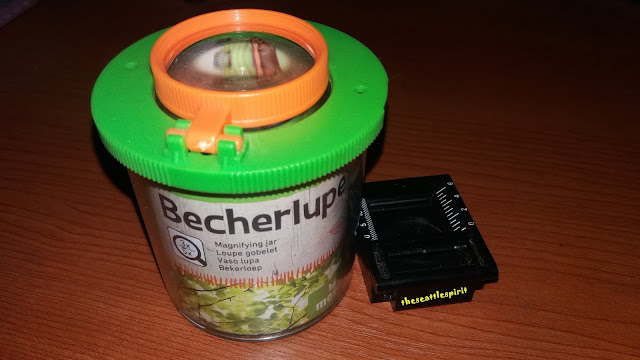Hello everyone. It's been a long time I am not sharing any posts. So at this moment, I want to share a review. The review is about two things that I got from my teacher as a gift.
But before I start the review, I will share my story behind these things.
But Mr Johan said it's really okay. A biologist mindset is required in agriculture particularly to know the detail of every living thing. More we know them, more we can control or manage it well. For example, we can control pest by the natural enemy. It will be healthier for the product (vegetables, etc), environment (healthy soil, water and non-target species), and no resistant effect. That sound's great. But to do that, I need to practise by visiting the corp, do some observation, and something like that. Then he gave me tools to help me do it. Those are cloth magnifier and magnifying jar.
1. Cloth Magnifier/Folding Linen Tester Magnifier
Application: a. Unfolded the cloth magnifier by following the pictures below
Price: I don't know for sure. But there are two kinds of this cloth magnifier, one use battery+LED and the other one does not use it. The first one is more expensive than the second one. Please check it on the online store.
B. Magnifying Jar
Application:
So, last month, I joined a training. It's an agriculture training with Mr Johan Schoenmakers as a trainer from PUM. That's really boarded my knowledge especially in agriculture which very related to biology. And of course the networking too, that's really amazing to know him and all participants as well. I listen to their experience, story and share nice conversation. Therefore, I am glad to be one of the participants.
In that training, Mr Johan Scoenmakers found me take an interest in insect and plant. My mindset is also really different from the other participant. Mostly the participant background is farmers, or student with agriculture, agribusiness, agrotechnology as their major. Automatically, if they see any insect as a pest in the corp they want to kill it. But spontaneously, I said we can't kill it, because every living thing wants to live. Yeah, it's corny. At that moment I feel awkward. I think everyone knows not every insect is a pest. But sometimes in nature, we can find a new thing. Even they look visually similar, we need to make sure about that, is it a pest or maybe actually it's a predator (natural enemy)?
But Mr Johan said it's really okay. A biologist mindset is required in agriculture particularly to know the detail of every living thing. More we know them, more we can control or manage it well. For example, we can control pest by the natural enemy. It will be healthier for the product (vegetables, etc), environment (healthy soil, water and non-target species), and no resistant effect. That sound's great. But to do that, I need to practise by visiting the corp, do some observation, and something like that. Then he gave me tools to help me do it. Those are cloth magnifier and magnifying jar.
These tools have the same function with my macro lens for my phone. But still, they have another advantage.
1. Cloth Magnifier/Folding Linen Tester Magnifier
For the first time, i called this tool as hand-microscope. It's because I don't know what the name exactly. And unfortunately, i didn't ask him what it is. So, i search it on the internet and i found the name and the detail. It's a cloth magnifier. It's not only used by the agronomist but also the woven fabric, jeweller, watch industry to magnify small objects. It's simple we can bring it anywhere because it's a small tool and it can be folded. Also equipped with scale and measurement in inch and mm units.
Application: a. Unfolded the cloth magnifier by following the pictures below
b. Put the object under the lens.
c. Start to observe
Price: I don't know for sure. But there are two kinds of this cloth magnifier, one use battery+LED and the other one does not use it. The first one is more expensive than the second one. Please check it on the online store.
B. Magnifying Jar
This one is bigger than the first one. It because of its advantages; temporary storage for the specimen. For more detail of this tool, i write the information from the packaging:
- It's a mini-terrarium for catching, collecting, and observing small insects and other living creatures.
- 3x and 5x magnification features a removable magnifying lid and includes air holes.
Application:
- Turn the lid to open the jar.
- Put the specimen in the jar.
- Turn the lid to close the jar.
- Start to observe
Price: Leden (Member) € 3,50; Niet Leden (Non Member) € 3,95.
P.S I really thank Mr Johan Schoenmakers for everything. I appreciate it





Comments
Post a Comment